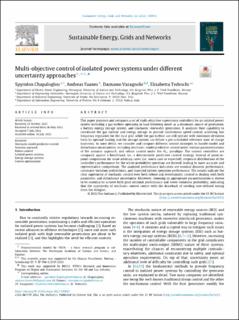| dc.description.abstract | This paper proposes and compares a set of multi-objective supervisory controllers for an isolated power system including a gas turbine operating in load following mode as a dominant source of generation, a battery energy storage system, and stochastic renewable generation. It analyzes their capability to coordinate the gas turbine and energy storage to provide isochronous speed control, achieving fast frequency regulation for the local grid, while the gas turbine can still operate with minimum deviation from its optimal loading and the storage system can follow a pre-scheduled reference state of charge trajectory. In more detail, we consider and compare different control strategies to handle model and disturbance uncertainties, including stochastic model predictive control under various parametrizations of the scenario approach, and robust control under the paradigm. The various controllers are compared against a benchmark, i.e., a deterministic predictive control strategy. Instead of point-to-point comparisons for some arbitrary cases (i.e., worst-case or expected), empirical distributions of the controller’s performance for the whole probability spectrum are derived, leading to more accurate and representative comparisons. The analyzed performance indicators are nominal dynamic performance, constraint violation probabilities, and expected system operation performance. The results indicate the clear superiority of stochastic control over both robust and deterministic control in dealing with both parametric and disturbance uncertainty. Moreover, choosing an appropriate parametrization is shown to be essential to achieve both good nominal performance and lower violations probability, indicating that the superiority of stochastic control comes with the drawback of needing user-defined tuning from the designer. | en_US |

